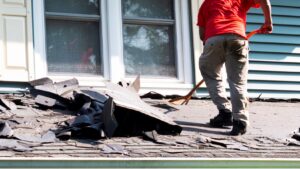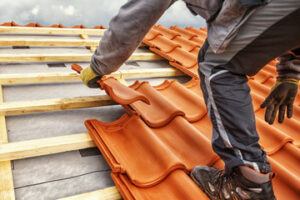A good rule of thumb is to inspect your roof every other year. Look for granule loss, algae streaks and missing asphalt shingles.

Repairing a single damaged area can save homeowners from more costly repairs down the road. However, continuous issues may warrant a complete roof replacement. A new roof protects your home, adds value and ensures peace of mind. Contact Victory Roof Repair Las Vegas for professional help.
Damaged roof shingles or tiles can expose your home to leaks and moisture, leading to serious damage. If you notice any shingles that have been cracked, torn, or are missing chunks of the roof, it’s essential that you have them replaced right away. Missing shingles leave exposed spots on the roof that can be susceptible to further weather damage and lead to leaking, mold formation, wood rot, and other costly repairs. Fortunately, damaged shingles are relatively easy to repair on most types of roofs.
Asphalt shingle roofs are particularly susceptible to damage from hailstorms. If you’ve experienced a recent hailstorm, it’s a good idea to have an inspection done of your roof as soon as possible. A professional roofer will examine the shingles for signs of damage, such as circular cracks or bruises that are sometimes difficult to see.
Once you’ve identified any areas of damaged shingles, you’ll need to gather the necessary tools to perform the repair. This may include a ladder, a pair of work gloves, and replacement shingles that match the existing style of your roof. If you’re unsure of the exact color or type of tiles you need, contact your roofing company to ask for advice.
If you’re replacing a single damaged shingle, start by checking to see if you have any spares in storage. If not, it’s a good idea to purchase a bundle of replacement shingles from a local roofing supplier or manufacturer. Once you’ve located the right shingles, start the repair process by removing the first row of nails beneath the damaged shingle. Slide a pry bar beneath the shingle, and gently lift to break the sealer strip connection with the shingle above it.
Next, remove the shingle from its nail hole and use a utility knife to cut away any remaining bits of the old shingle. Depending on the severity of the damage, you might be able to simply apply roofing sealant over the area and then press down a new shingle over it. Alternatively, you might need to replace the entire shingle.
Leaks
Imagine waking up in the middle of a storm and finding water stains on your ceiling. What’s worse, the water may be causing damage to your walls and contents as it seeps into the home. While it may seem like the roof needs to be replaced altogether, oftentimes, targeted repairs can solve the problem and prolong the life of the roof.
Identifying the source of the leak is the first step. It’s important to note that water doesn’t drip straight down; it follows gravity and travels along beams and insulation until it hits a vulnerable point and shows up on the ceiling. This means you need to look for a trail of moisture to determine the source.
Chimneys, vent pipes, skylights, and other roof penetration points can be leak sources if the flashing or seals are damaged. Check these areas regularly to keep them leak-free and up to code.
Leaks can also be caused by roof deterioration, or a lack of proper attic insulation and ventilation. Be sure to check these areas as well as any mechanical equipment on the roof such as swamp coolers and HVAC units.
If you find a leaky area, it is best to stay safe and hire a professional. A skilled metal roofing contractor will know how to properly repair your roof without requiring an entire roof replacement.
Before you go on the roof, be sure to wear sturdy shoes and use a ladder that is secured. Wet shingles are extremely slippery and dangerous to walk on. If possible, have a spotter inside the house to watch for signs of water intrusion.
If you have a small leak, apply a bead of high-quality roofing caulk or sealant around the leaky area. Be sure to choose a product that is compatible with your metal roof’s material. A large leak, however, will require you to puncture the sagging bulge in the ceiling with a screwdriver and release any collected water. This will help prevent the bulge from spreading or bursting, allowing further water to flow into the home. Be sure to place buckets or pans beneath the puncture to catch any leaking water.
Sagging
The natural aging process and extreme weather can weaken the underlying structure of your roof. Over time, this can lead to sagging, especially if you neglect regular maintenance. Smaller problems like dislodged shingles and water-warped rafters can become large structural issues, which can be very costly to repair.
Taking measures to prevent these problems is vital for the overall health of your roof. Regularly clearing debris and removing snow, inspecting your attic and fixing leaks as soon as they occur, and scheduling regular maintenance from professional roofing professionals can help you avoid a costly roof replacement down the road.
If you notice a sagging ridge line or that the center of your roof has become wavy, this is a sign that it’s time to call a professional. A little bit of sagging is normal, but major sagging can lead to expensive structural damage inside your home.
One of the leading causes of roof sagging is excessive weight. If your roof is too heavy for its materials, or if it was built with insufficient support, this can cause it to collapse under its own weight. This is a very dangerous situation and should never be ignored.
Another reason for sagging is excess moisture. Leaks and poor drainage can allow water to seep into the roof framing and cause rot or mildew, which can further weaken the wood. This can also make the joists and trusses of your roof soft and brittle, making them unable to support the weight of the roof as they should.
The good news is that most sagging can be fixed by fortifying the roof’s structure with stronger materials and adding steel supports. This may be as simple as jacking up loose rafters and adding struts, but more severe structural issues will require the help of a qualified professional.
Water Damage
Water damage caused by a leaky roof can spread quickly, and if left unattended it could lead to mold growth, serious health issues and structural problems in your home. The best way to avoid these issues is to catch and address problems as soon as they occur.
To fix a leaky roof, roofing professionals may use a variety of methods depending on the location and severity of the leak. For example, they might add more drainage points to the roof, or slightly modify the slope of the roof using tapered insulation or built-up materials to improve water runoff and prevent future ponding. In addition, they might replace missing shingles or patch small holes with a waterproof sealant, and they might also repair damaged flashing or tin vents.
The most important thing to do if you discover water damage is to thoroughly dry the affected area with fans and dehumidifiers. Moisture can lead to rot and other structural problems, and it can also cause irreparable damage to sensitive electronic components such as computers and phones. It’s important to move these items away from the wet areas and store them on shelves or in containers to keep them safe from moisture.
If you have water stains on your ceiling or walls, it’s important to identify the source of the leak and find the area where water is seeping in. Then, you can take steps to make the necessary repairs.
Water leaks typically appear as dark stains on your ceiling or wall, but it’s important to trace the source of the leak to prevent further damage to your home. It’s also a good idea to check the attic for signs of leaks or water damage, as well as any other areas where moisture might be present in your home.
Whether you have a minor leak or extensive water damage, it’s always best to hire professional roofing contractors for a thorough assessment and effective repairs. Taking a DIY approach to roof repair can be dangerous, and it’s often more cost-effective in the long run to invest in a qualified roofing contractor.
